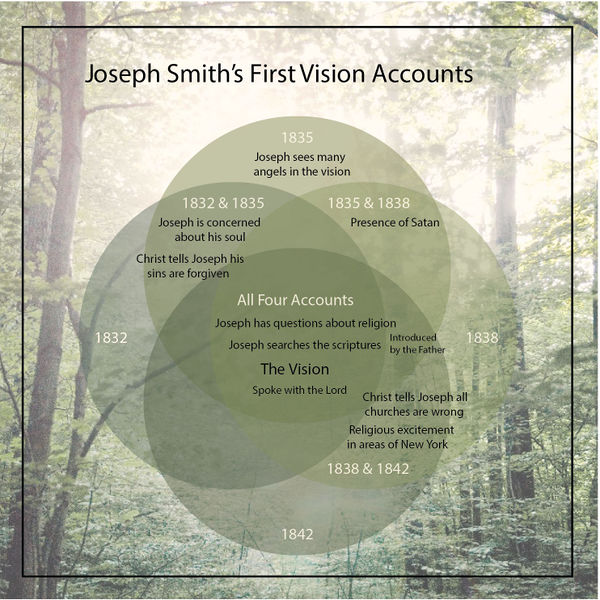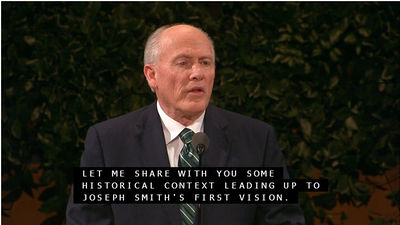
FAIR is a non-profit organization dedicated to providing well-documented answers to criticisms of the doctrine, practice, and history of The Church of Jesus Christ of Latter-day Saints.
I am not worried that the Prophet Joseph Smith gave a number of versions of the first vision anymore than I am worried that there are four different writers of the gospels in the New Testament, each with his own perceptions, each telling the events to meet his own purpose for writing at the time. I am more concerned with the fact that God has revealed in this dispensation a great and marvelous and beautiful plan that motivates men and women to love their Creator and their Redeemer, to appreciate and serve one another, to walk in faith on the road that leads to immortality and eternal life.
—Gordon B. Hinckley, “God Hath Not Given Us the Spirit of Fear,” Ensign, Oct 1984, 2 off-site
Critics of Mormonism have delighted in the discrepancies between the canonical [1838 PGP] account and earlier renditions, especially one written in Smith's own hand in 1832. For example, in the 1832 version, Jesus appears to Smith alone, and does all the talking himself. Such complaints, however, are much ado about relatively nothing. Any good lawyer (or historian) would expect to find contradictions or competing narratives written down years apart and decades after the event. And despite the contradictions, key elements abide. In each case, Jesus appears to Smith in a vision. In each case, Smith is blessed with a revelation. In each case, God tells him to remain aloof from all Christian denominations, as something better is in store.
—Stephen Prothero, American Jesus: How the Son of God Became a National Icon (New York: Farrar, Straus and Giroux, 2003), 171.
President Dallin H. Oaks explained, "As a boy, Joseph Smith had not [kept a record]. His formal education was limited, paper was expensive and it was not customary for poor farm boys in the United States to keep journals. That is why we lack contemporaneous accounts of his earliest visions."[1]
Joseph adjusted and emphasized certain portions of his narrative of the First Vision to account for his audience, as well as to incorporate his evolving understanding of Church doctrine. This is not unusual:
We often edit or entirely rewrite our previous experiences—unknowingly and unconsciously—in light of what we now know or believe. The result can be a skewed rendering of a specific incident, or even of an extended period in our lives, that says more about how we feel now than what happened then. Thus, without knowing it, we can modify our own history.” [4]
The Church has published information about the various First Vision accounts since at least 1970. Critics of the Church of Jesus Christ of Latter-day Saints often seek to point out differences between the various accounts which Joseph Smith gave of his First Vision. In defense of their position that the Prophet changed his story over a six year period (1832 to 1838) they claim that the earliest followers of Joseph Smith either didn’t know about the First Vision, or seem to have been confused about it. The Church, however, has discussed the various accounts in a number of publications. Joseph Smith's various accounts of the First Vision were targeted at different audiences, and had different purposes. They, however, show a remarkable degree of harmony between them. There is no evidence that the early leaders of the LDS Church did not understand that the Prophet saw two Divine Personages during his inaugural theophany.


Elder Richard J. Maynes, Presidency of the Seventy, at the Worldwide Young Adult Devotional held 1 May 2016 in the Salt Lake Tabernacle:
Let me share with you some historical context leading up to Joseph Smith's First Vision...Joseph wrote or dictated four known accounts of his First Vision. Additionally, his contemporaries recorded their memories of what they heard Joseph say about the vision; five such accounts are known. It is a blessing to have these records. They make Joseph’s First Vision the best-documented vision in history. I encourage you to visit history.lds.org to learn more about the accounts and see how they work together to paint a more complete picture...Like the individual New Testament Gospels that together more completely describe Christ’s life and ministry, each one of the accounts describing Joseph’s First Vision adds unique detail and perspective to the total experience. They together tell Joseph’s consistent, harmonious story. They all emphasize that there was confusion and strife among Christian churches, that Joseph desired to know which — if any — was right, that he searched the scriptures and prayed, that a light descended from heaven, and that divine beings appeared and answered his prayer.—(Click here to continue) [5]
Gospel Topics on LDS.org:
The various accounts of the First Vision tell a consistent story, though naturally they differ in emphasis and detail. Historians expect that when an individual retells an experience in multiple settings to different audiences over many years, each account will emphasize various aspects of the experience and contain unique details. Indeed, differences similar to those in the First Vision accounts exist in the multiple scriptural accounts of Paul’s vision on the road to Damascus and the Apostles’ experience on the Mount of Transfiguration.3 Yet despite the differences, a basic consistency remains across all the accounts of the First Vision. Some have mistakenly argued that any variation in the retelling of the story is evidence of fabrication. To the contrary, the rich historical record enables us to learn more about this remarkable event than we could if it were less well documented. [6]—(Click here to continue)
Doctrine and Covenants and Church History Seminary Teacher Manual (2013), LESSON 6: Joseph Smith—History 1:1–20:
Just as Joseph Smith emphasized different aspects of his vision in his multiple accounts, the Apostle Paul emphasized different aspects of his vision of the Savior to different audiences (see Acts 9:1–9; Acts 22:5–11; Acts 26:12–20). Why do you think Joseph Smith and Paul emphasized different things each time they related the accounts of their visions? [7]
Milton V. Backman, Ensign (January 1985):
On at least four different occasions, Joseph Smith either wrote or dictated to scribes accounts of his sacred experience of 1820. Possibly he penned or dictated other histories of the First Vision; if so, they have not been located. The four surviving recitals of this theophany were prepared or rendered through different scribes, at different times, from a different perspective, for different purposes and to different audiences.1 It is not surprising, therefore, that each of them emphasizes different aspects of his experience.[8]
James B. Allen, Improvement Era (April 1970):
Nevertheless, it can now be demonstrated that the Prophet described his experience to friends and acquaintances at least as early as 1831-32, and that he continued to do so in varying detail until the year of his death, 1844. We presently know of at least eight contemporary documents that were written during his lifetime.[9]
Dennis B. Neuenschwander, Ensign (January 2009):
Joseph's vision was at first an intensely personal experience—an answer to a specific question. Over time, however, illuminated by additional experience and instruction, it became the founding revelation of the Restoration. [10]
Gordon B. Hinckley, Ensign (October 1984):
I am not worried that the Prophet Joseph Smith gave a number of versions of the first vision anymore than I am worried that there are four different writers of the gospels in the New Testament, each with his own perceptions, each telling the events to meet his own purpose for writing at the time. I am more concerned with the fact that God has revealed in this dispensation a great and marvelous and beautiful plan that motivates men and women to love their Creator and their Redeemer, to appreciate and serve one another, to walk in faith on the road that leads to immortality and eternal life.[11]
Stephen Prothero, American Jesus: How the Son of God Became a National Icon (2003):
Critics of Mormonism have delighted in the discrepancies between the canonical [1838 PGP] account and earlier renditions, especially one written in Smith's own hand in 1832. For example, in the 1832 version, Jesus appears to Smith alone, and does all the talking himself. Such complaints, however, are much ado about relatively nothing. Any good lawyer (or historian) would expect to find contradictions or competing narratives written down years apart and decades after the event. And despite the contradictions, key elements abide. In each case, Jesus appears to Smith in a vision. In each case, Smith is blessed with a revelation. In each case, God tells him to remain aloof from all Christian denominations, as something better is in store.[12]
There are essentially three arguments against the first vision. The minister to whom Joseph reported the event announced that there were no such things these days. More than a century later Fawn Brodie wrote with literary grace to mask historical deficiencies that Joseph concocted the vision years after he said it happened. Then a generation later Wesley Walters charged Joseph with inventing revivalism when a lack of historical evidence proved that there was none, and therefore no subsequent vision as a result. So by now it has become a foregone conclusion for some there are no such things as visions, and Joseph failed to mention his experience for years and then gave conflicting accounts that didn’t match historical facts.
Summary: The claim is sometimes made by critics that the Church hides the various accounts of Joseph Smith's First Vision that are not in its official canon. The following chronological database (compiled by FAIR volunteer Edward Jones) demonstrates conclusively that this is simply not the case. The various accounts of the First Vision have been widely acknowledged in LDS-authored sources throughout the twentieth and twenty-first centuries.
Notes

FAIR is a non-profit organization dedicated to providing well-documented answers to criticisms of the doctrine, practice, and history of The Church of Jesus Christ of Latter-day Saints.
We are a volunteer organization. We invite you to give back.
Donate Now